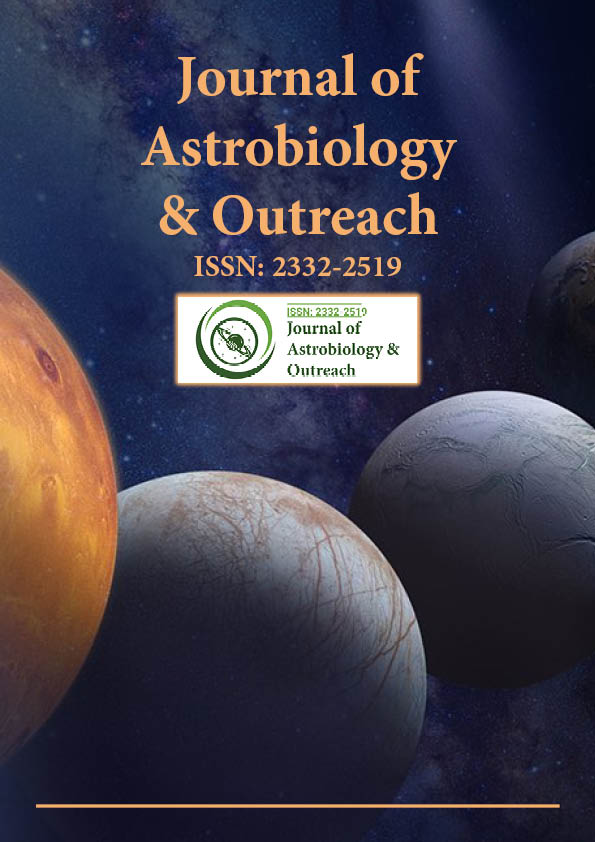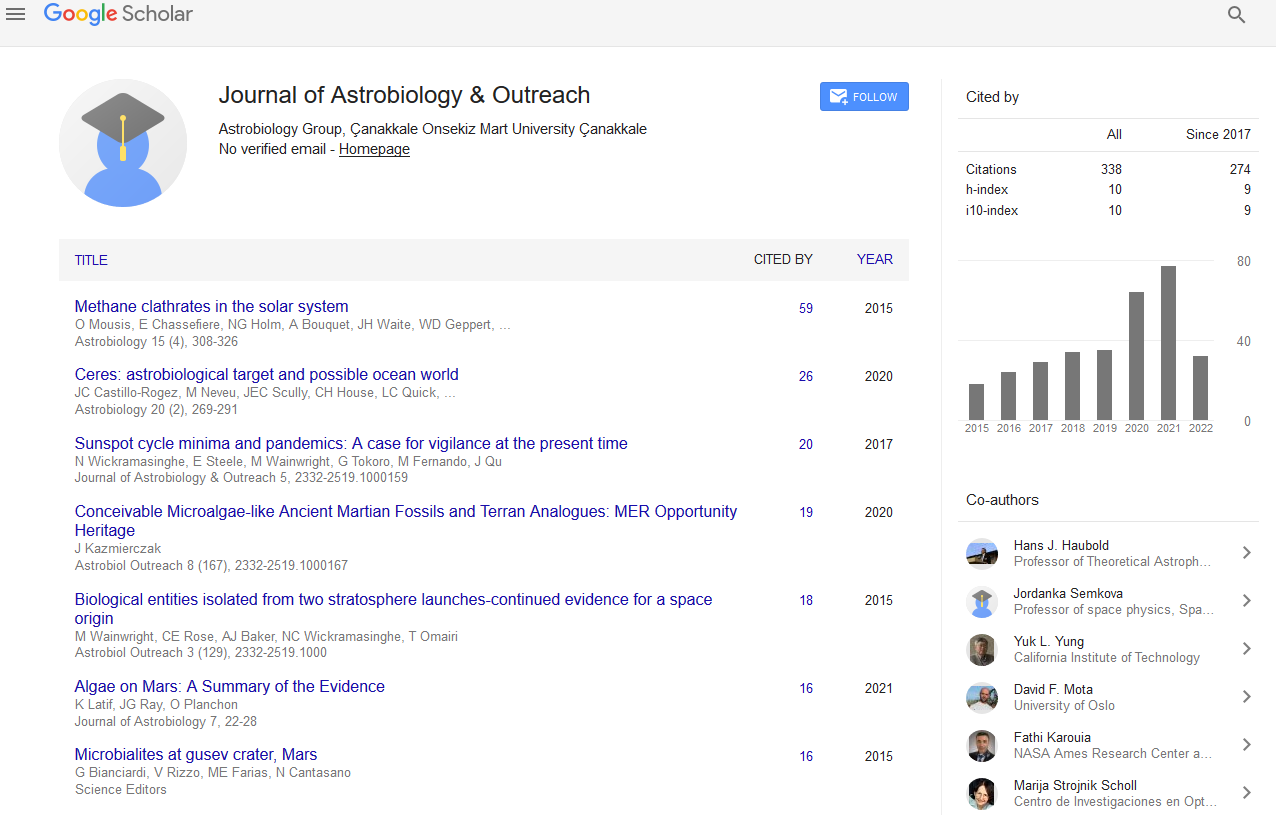Indexed In
- Open J Gate
- Academic Keys
- JournalTOCs
- RefSeek
- Hamdard University
- EBSCO A-Z
- OCLC- WorldCat
- Google Scholar
Useful Links
Share This Page
Journal Flyer

Open Access Journals
- Agri and Aquaculture
- Biochemistry
- Bioinformatics & Systems Biology
- Business & Management
- Chemistry
- Clinical Sciences
- Engineering
- Food & Nutrition
- General Science
- Genetics & Molecular Biology
- Immunology & Microbiology
- Medical Sciences
- Neuroscience & Psychology
- Nursing & Health Care
- Pharmaceutical Sciences
Commentary - (2024) Volume 13, Issue 2
Exobiology Exploration and Insights in Habitable Zone
Alyson Lim*Received: 16-Dec-2023, Manuscript No. JAO-23-24460; Editor assigned: 19-Dec-2023, Pre QC No. JAO-23-24460; Reviewed: 02-Jan-2025, QC No. JAO-23-24460; Revised: 22-Jan-2025, Manuscript No. JAO-23-24460; Published: 29-Jan-2025, DOI: 10.35248/2332-2519.25.13.375
Desciption
Exobiology, also known as astrobiology, is a fascinating and multidisciplinary scientific field that seeks to understand the potential for life beyond Earth. As humans gaze into the vastness of the cosmos, the question of whether life exists elsewhere in the universe has captivated the imaginations of scientists, astronomers, and the general public alike. Exobiology explores the conditions necessary for life, the potential habitats that might support it, and the methods by which it could detect signs of extraterrestrial life.
Exobiology is the branch of biology that extends its focus beyond Earth, examining the possibilities of life in the broader universe. It encompasses a wide range of scientific disciplines, including astronomy, chemistry, geology, and biology. Understanding the conditions necessary for life to exist is significant in the field of exobiology. Scientists explore the habitability of celestial bodies based on factors such as temperature, atmospheric composition, and the availability of liquid water. Water, in particular, is considered a key ingredient for life and the search for it on other planets and moons is a focal point of exobiological research.
One of the most extensively studied celestial bodies in the quest for extraterrestrial life is Mars. With its similar day-night cycle and evidence of liquid water in the past, Mars has been a primary target for exobiological exploration. Rovers and orbiters, such as the Mars curiosity rover and the Mars reconnaissance orbiter, have been deployed to analyze the Martian surface, searching for signs of past or present life.
The moons harbor subsurface oceans beneath their icy crusts, raising the possibility of environments suitable for life. Scientists speculate that the tidal heating generated by gravitational interactions with their host planets may provide the necessary energy for life to thrive in these subsurface oceans. The study of extremophiles organisms that thrive in extreme environments on earth provides valuable insights for exobiologists. These extremophiles, found in environments such as deep-sea hydrothermal vents and acidic hot springs, showcase the adaptability of life to harsh conditions. By understanding how life can persist in extreme environments on Earth, scientists gain a better understanding of the potential habitability of exoplanets and Moons.
The discovery of exoplanets, planets outside our solar system, has opened up new possibilities for exobiological exploration. The identification of habitable zones, where conditions may be suitable for liquid water, is a key criterion for assessing the potential for life on exoplanets. Telescopes like the Kepler space telescope have contributed significantly to the discovery of thousands of exoplanets, expanding the list of potential targets for exobiological investigations. In addition to exploring celestial bodies within our solar system, the Search for Extraterrestrial Intelligence (SETI) is a vital aspect of exobiology. SETI involves monitoring radio signals and other electromagnetic emissions from space to detect potential signs of intelligent extraterrestrial civilizations.
The vast distances between celestial bodies and the limitations of current space exploration technologies present obstacles to direct investigations. The future of exobiology hinges on advancements in technology, such as improved space probes, telescopes, and analytical instruments. Collaborative efforts between space agencies, research institutions, and the private sector will be significant in advancing our understanding of the potential for life beyond Earth. Exobiology stands at the forefront of scientific inquiry, fueling our curiosity about the existence of life beyond our home planet. Through the exploration of Mars, the moons Europa and Enceladus, the study of extremophiles on Earth, and the search for habitable exoplanets, scientists are gradually resolve the mysteries of the cosmos.
Citation: Lim A (2025) Exobiology Exploration and Insights in Habitable Zone. J Astrobiol Outreach. 13:375.
Copyright: © 2025 Lim A. This is an open-access article distributed under the terms of the Creative Commons Attribution License, which permits unrestricted use, distribution, and reproduction in any medium, provided the original author and source are credited.

